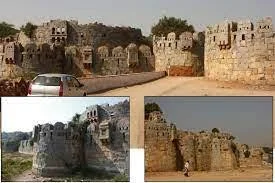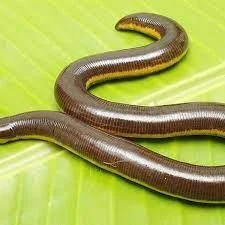UPSC GS 1
Mudgal Fort
- News: The Mudgal Fort in Karnataka stands as a remarkable testament to the historical and cultural richness of India, showcasing various architectural, cultural, and historical elements spanning over a millennium.
- Location and Historical Significance:
- Located in Karnataka, Mudgal Fort has a history dating back 1000 years.
- It has witnessed the rule of various dynasties including the Chalukyas, Rashtrakutas, Deccan Sultanate, and Vijayanagara Empire.
- The fort gained prominence during the Bahmani Sultanate era, particularly under the rule of the Adil Shahi Sultanate of Bijapur and later the Vijayanagara Empire.
- Strategic Importance:
- Positioned on the border between the Adil Shahi Sultanate and Vijayanagara Empire, Mudgal Fort was strategically vital.
- It saw numerous battles between the 14th and 16th centuries, as both empires vied for control over the fertile Raichur Doab region.

- Cultural and Architectural Features:
- The fort exhibits a blend of architectural styles reflecting its diverse cultural influences over the centuries.
- Notable structures within the fort include the Ranganathaswamy Temple and the Hussain Alam Dargah, which stand side-by-side, highlighting the religious harmony and cultural syncretism of the region.
- The fort is fortified with several gates, such as the Fateh Darwaza on the north side, known for its intricate carvings and strategic design.
- Inscriptions and Historical Records:
- Mudgal Fort boasts as many as 99 inscriptions in various languages including Kannada, Sanskrit, Telugu, Persian, Arabic, and Gujarati.
- These inscriptions provide insights into the military history, cultural exchanges, and societal dynamics of the region.
- One notable inscription commemorates the military achievements of Malik Murad Khan, a general under Ibrahim Adil Shah II, who played a significant role in battles against the Vijayanagara Empire.
- Legacy and Cultural Significance:
-
- As a cultural and historical landmark, Mudgal Fort continues to be a symbol of the region’s power and heritage.
- It represents the resilience and architectural prowess of the civilizations that once thrived in the Deccan Plateau.
See this: Indian Migrants in Gulf Countries: Opportunities and Challenges UPSC
Chenab Rail Bridge
- News: The Indian Railway conducted a successful trial run on the newly-constructed Chenab Rail Bridge, the world’s highest railway bridge, located in Jammu and Kashmir.
- Location: Between Bakkal and Kauri in the Reasi district of Jammu and Kashmir (J&K).
- Height and Length: The bridge spans 1.3 km in length and is located 359 meters above the Chenab riverbed.
- Distinction: It is the highest single-arch railway bridge in the world.
- Project: It is a part of the Udhampur-Srinagar-Baramulla Rail Link project.
- Collaboration: The construction involved various international organizations and renowned Indian institutions, including the Indian Institutes of Technology (IITs), the Defence Research and Development Organisation (DRDO), and the Geological Survey of India.
- Spans: The bridge consists of 17 spans, with the main arch spanning 467 meters, the longest of its kind.
- Arch Construction: The arch consists of steel boxes filled with concrete to improve stability.
- Deck Segments: The bridge comprises 93 deck segments, each weighing approximately 85 tonnes.
- Design Life: The bridge has been designed with a life span of 120 years.
- Wind Resistance: It can withstand high wind speeds of up to 266 km/h.
- Blast-Proof and Earthquake Resistance: The bridge is built to be blast-proof and is capable of withstanding the maximum intensity zone-V earthquake forces in the nation.
- Key Facts about Chenab River:
- Countries: India and Pakistan
- Major River: Tributary of the Indus River
- Origin: Formed by the confluence of two streams, Chandra and Bhaga, at Tandi in the upper Himalayas in the Lahaul and Spiti Districts of Himachal Pradesh.
- Upper Reaches Name: Known as the Chandrabhaga in its upper reaches.
- Flow Path in India: Flows west through the Jammu and Kashmir union territory, between the steep cliffs of the Siwalik Range (south) and the Lesser Himalayas (north).
- Flow Path in Pakistan: Turns southwest, continues into Pakistan, descending from the uplands into the broad alluvial lowlands of Punjab province.
- Confluence and Termination: After receiving the Jhelum River near Trimmu, the Chenab empties into the Sutlej River, a tributary of the Indus River.
- Total Length: Approximately 605 miles (974 km)
- Irrigation: Feeds several irrigation canals.
- Tributaries:
- Miyar Nalla
- Sohal
- Thirot
- Bhut Nalla
- Marusudar
- Lidrari
UPSC GS 3
Caecilians
- News: A team of herpetologists in Kaziranga National Park recorded the striped caecilian (Ichthyophis spp) for the first time during a recent rapid herpetofauna survey.
- General Characteristics: Elongated, Segmented, Limbless Amphibians: Caecilians are known for their elongated, segmented bodies and lack of limbs.
- Order Gymnophiona or Apoda: They are classified in the order Gymnophiona or Apoda, which means “without legs.”
- Related to Frogs and Salamanders: Caecilians belong to the same group of animals as frogs and salamanders.

- Appearance: Lacking limbs, caecilians resemble earthworms or snakes.
- Name Origin: The name “Caecilian” means “blind,” reflecting that some species are eyeless, while others have small eyes hidden under their skin.
- Geographical Range: Most caecilians inhabit moist tropical and subtropical regions of South and Central America, South and Southeast Asia, and Sub-Saharan Africa.
- Terrestrial Lifestyle: Almost all caecilians are terrestrial and spend the majority of their lives underground.
- Burrowing Habits: They primarily burrow in forests, but also inhabit grasslands, savannas, shrublands, and wetlands.
- Size Variations: Smaller species measure less than three inches, whereas the largest species (Caecilia thompsoni from Colombia) can grow to almost five feet long.
- Skull and Snout: They have a hard, thick skull with a pointy snout that helps them move effectively through dirt or mud.
- Skin: Their shiny skin is ringed with folds called annuli, and they usually come in shades of gray, brown, black, orange, or yellow. Some species have tiny, fish-like scales within the rings.
- Sensory Tentacles: Located between their eyes and nostrils, these short sensory tentacles help them probe their environment and find prey.
Human African Trypanosomiasis (HAT)
- News: Chad has become the first country in 2024 and the 51st globally to eliminate a neglected tropical disease (NTD) called human African trypanosomiasis (HAT), also known as sleeping sickness disease.
- Common Name: Sleeping sickness
- Cause: Protozoan parasites transmitted by infected tsetse flies
- Geographical Range: Endemic in sub-Saharan Africa
- Forms of HAT: HAT takes two forms, depending on the subspecies of the infecting parasite:
- Trypanosoma brucei gambiense:
- Region: Found in 24 countries of West and Central Africa
- Prevalence: Accounts for 92% of reported cases
- Illness Type: Causes a chronic illness
- Infection Duration: A person can be infected for months or even years without major signs or symptoms
- Symptoms: When symptoms do emerge, the disease is often advanced with the central nervous system already affected
- Trypanosoma brucei rhodesiense:
- Region: Found in 13 countries of Eastern and Southern Africa
- Prevalence: Accounts for 8% of reported cases
- Illness Type: Causes an acute disease
- Infection Duration: Symptoms emerge a few weeks or months after infection
- Symptoms: The disease develops rapidly with multi-organ invasion, including the brain
- Vector: Tsetse flies, with only certain species transmitting the disease
- Risk Groups: Rural populations dependent on agriculture, fishing, animal husbandry, or hunting are most exposed
- WHO Validation of Elimination: The gambiense form of HAT has been validated as eliminated in seven countries by WHO:
-
- Togo: 2020
- Benin: 2021
- Ivory Coast: 2021
- Uganda: 2022
- Equatorial Guinea: 2022
- Ghana: 2023
- Chad: 2024
-
- Neglected Tropical Diseases (NTDs):
- Definition: Neglected tropical diseases (NTDs) are a diverse group of tropical infections that are prevalent in low-income populations in developing regions of Africa, Asia, and the Americas.
- Common Regions: Primarily affect populations in developing regions of Africa, Asia, and the Americas.
- Causes:
- Viruses
- Bacteria
- Protozoa
- Parasitic Worms (Helminths)
- Neglect: They are termed “neglected” because they have been largely overlooked by global health initiatives compared to other diseases such as HIV/AIDS, tuberculosis, and malaria.
- Diversity: The group includes a wide range of diseases, each with different modes of transmission, symptoms, and health impacts.
Read also: Western Disturbances: Origin, Spread, Effects and Climate Change | UPSC
Hooch
- News: Recently, at least 34 people have died, and around 100 others have been hospitalized after consuming hooch, or spurious liquor, in Tamil Nadu’s Kallakurichi.
- Definition: Hooch is a commonly used term for poor quality alcohol. The term is derived from Hoochinoo, a native Alaskan tribe known for producing very strong liquor.
- Production Setting: Unlike branded liquor produced in factories with sophisticated equipment and rigorous quality control, hooch is made in crude settings.
- How is Hooch Produced?
- Basic Processes: All alcohol is produced using two basic processes: fermentation and distillation.
- Fermentation:
- Process: When heated, yeast reacts with sugar (from grain, fruits, sugarcane, etc.) to ferment and produce a mixture containing alcohol. This age-old process is used to create beverages like beer or wine.
- Limitation: As fermentation continues and alcohol levels rise, conditions in the mixture become toxic for the yeast. Eventually, no more fermentation can take place. To produce anything stronger (above 14-18% ABV), beverages need to be distilled.
- Distillation:
- Process: Distillation physically separates alcohol from a fermented mixture using evaporation and condensation. Since different parts of the mixture have different boiling points, heating it to the correct temperature allows for the separation of alcohol from water and other remnants.
- Outcome: Distilled beverages, or spirits, are far more potent than any fermented beverage.
- Why Can Hooch Be Dangerous?
- Methanol Contamination: The fermented mixture which is distilled contains more than just consumable alcohol (ethanol). It also contains methanol, an industrial alcohol that is highly toxic for humans.
- Methanol Concentration: Non-distilled alcoholic beverages like wine contain relatively harmless trace amounts of methanol. However, during distillation, both ethanol and methanol are concentrated. Incorrect distillation can lead to a product with high quantities of toxic methanol.
- Effects of Spurious Liquor:
-
- Health Risks: Methanol or methyl alcohol can cause impaired vision, high toxicity, and metabolic acidosis, a condition where the body produces excessive acid that the kidneys cannot flush out.
- Treatment: The treatment involves intravenously administering fomepizole and ethanol. However, fomepizole can be expensive and unavailable in many parts of India.
- Alternative Treatment: In such cases, doctors administer a mixture of ethanol and water (1:1 ratio). Ethanol inhibits methanol’s conversion into toxins and helps flush it out of the body either naturally or through dialysis.

